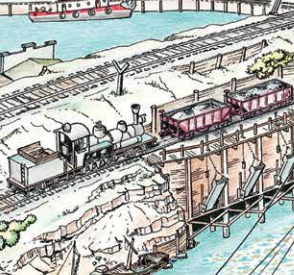Back when I was real active in the 60s and early 70s, my entire room sized layout didn't cost more than $200 total.
According to the US Bureau of Labor Statistics Consumer Price Index inflation calculator, $200 in August 1965 has the same buying power as does $1943.20 in August 2023.
And as it happens ...
Right this very moment I'm taking a break from working on another Trainz adaptation of a Model Railroader/Kalmbach Books trackplan; plan 82 from the classic 101 Track Plans.
My favorites in 101 Track Plans book are:
55, Belfast & Moosehead Lake, a 3 wall shelf layout, two terminals with turntables. (my all time most favorite track plan)
(have Belfast end of it in HO in the other room)
10, Pittsburg and Ironton, a 3x6 table with a horseshoe shaped mainline, with yard and switching. (eminently suitable for building in the 3D world split in to an L shelf)
My favorites in 101 More Track Plans are:
62, Santa Fe San Jacinto District, a 4 wall shelf layout based on orange growing. (my other all time most favorite track plan) Also includes station at Perris, California, which is now a RR museum.
Plan was in the 1st Model Railroader magazine I ever bought, February 1980.
Also rather like several other 3 wall and 2 wall shelf layouts in there.
A third Very Favorite track plan from Atlas in the track plan books they used to publish is an L shaped shelf layout for switching.
It is labeled Track Plan 205 in the 1957, 1970 book, Custom Line Layouts HO scale Railroads.
Have several versions of it going in Trainz.
All making use of greater real estate area available in electrons than in subsidized apartments.
Another favorite in there is Track Plan 208, Grade Crossing Deluxe, a bent waterwings plan with a complex interchange arrangement in the middle.
Have built a couple versions of it, with extended ends for much longer run.
Smaller switching oriented layouts have always appealed to me. Why? Unknown; I've not bothered to self-analyze that much. But they are a size I can maintain in real life with my always messy health. A thing which to a degree holds true here in Trainz where they are of a scale I can readily build, landscape, and operate.
Trainz also offers opportunity to build longer, far longer, routes suitable for mainline passenger trains such as classic US streamliners, with miles between stops.
Which is also a thing I really enjoy.

Guess one could say that switching industries and running passenger trains are my 2 favorite Trainz things.
Right after that is making little scenes in towns and landscaping.
Somehow I've ended up with 2 copies of TANE, one via the manufacturer and one via Steam.
The Steam one I've made more narrow gauge oriented & currently have several 600mm, 2ft, gauge layouts going. One based on that plan 55 and one quite large with about 5 miles between towns.
Am currently making some 600mm gauge 'town modules' of 2 or 3 boards each, based on track plans in various model and prototype books.
Ultimate goal is to merge them in to large layout/route with 5 to 10 miles between towns.
Have some engine terminal plans in books by both Kalmbach and Carstens Publications in New Jersey (now gone, they did Railroad Model Craftsman, which ;last I heard is now published by a company here in Missouri)
As well as small branch line and switching layouts I've got a thing for turntables and roundhouses.
(and if the US locomotive's smokestack goes through the wall over the door of the really cool British roundhouse with all the skylights, I'm okay with that, after all, it's only electrons, not styrene, brass, white metal, basswood, or the like) 

Well, didn't intend to write much of anything here today, let alone this much. But, hey, here it is.






